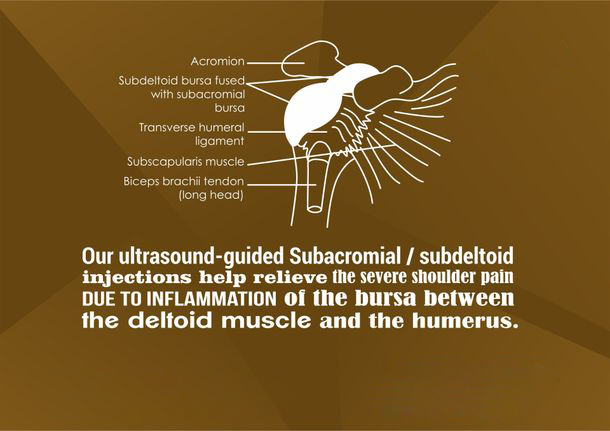

Treatments
SHOULDER, ELBOW & ARM PAIN

Subacromial / Subdeltoid Bursa Injection
What is Subacromial bursa injection and why do I need this?
A bursa is a gel-filled sac that helps the muscles and tendons glide smoothly over bones. You have bursae in your shoulders, elbows, hips, knees and other parts of your body. Subacromial bursa is in the shoulder, located below a part of the shoulder blade called acromion. It facilitates the motion of the supraspinatus tendon (a shoulder tendon) of the rotator cuff in activities such as overhead work. Subacromial bursa injection is indicated in conditions like Subacromial bursitis (inflammation of Subacromial bursa) and impingement syndrome, which causes shoulder pain.
You will be asked to lie on your tummy first, and then on your back, in the procedure table. The injection site is sterilised with either iodine or chlorhexidine and is numbed with a local anaesthetic. The needle is then directed to the target area under ultrasound, to ensure proper placement, and medication is slowly injected.
How is Subacromial bursa injection done?
At Atlas Pain Care, Coimbatore it is done on a day care basis in a clean room. Ultrasound of the shoulder is used to identify the Subacromial bursa and a thin needle is inserted into the bursa to inject the medications.
How effective is bursa injection?
Some patients report pain relief within 30 minutes after the injection. The pain relief might last for a few weeks to a few months. How long the pain stays away is different for each patient. For some, the relief is permanent. But if the pain returns, you can have another bursa injection in a few months.
What are the risks?
The risk of complication from a bursa injection is very low. However, there could be bruising, swelling or inflammation at the injection site.
Please read our FAQ section to know more about the do's and don'ts prior to and after the procedure.

